-
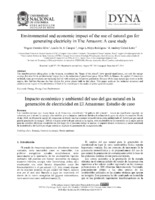 Environmental and economic impact of the use of natural gas for generating electricity in The Amazon: A case study
Environmental and economic impact of the use of natural gas for generating electricity in The Amazon: A case study Las transformaciones que tienen lugar en el Amazonas, considerado "el pulmón del planeta", tienen un significado especial, no
solamente por el ahorro de energía, sino también por su impacto ambiental debido a la reducción de gases de efecto invernadero. Desde
el año 2010, en Manaos la capital del Amazonas en Brasil, muchas centrales termoeléctricas están sustituyendo el fueloil por gas natural
para la generación de energía. Debido a la gran reserva de gas natural en la región, este combustible se ha convertido en la mejor opción
para las centrales eléctricas construidas en este lugar. En el presente trabajo se analiza el impacto técnico económico y medio ambiental
de la sustitución del fueloil por el gas natural en la planta de generación de energía analizada.
-
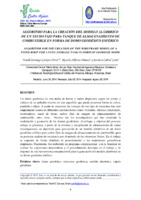 ALGORITMO PARA LA CREACIÓN DEL MODELO ALÁMBRICO DE UN TECHO FIJO PARA TANQUE DE ALMACENAMIENTO DE COMBUSTIBLE EN FORMA DE DOMO GEODÉSICO ESFÉRICO
ALGORITMO PARA LA CREACIÓN DEL MODELO ALÁMBRICO DE UN TECHO FIJO PARA TANQUE DE ALMACENAMIENTO DE COMBUSTIBLE EN FORMA DE DOMO GEODÉSICO ESFÉRICO Un domo geodésico es una malla de barras y nudos dispuestos según las aristas y
vértices de un poliedro inscrito en una superficie que puede presentar forma de esfera,
parábola o elipse. A partir de conocerse las ventajas de este tipo de estructura han sido
ampliamente usadas en diferentes construcciones como: viviendas, oficinas comerciales,
invernaderos, stand de ferias, techos fijos de tanques de almacenamiento de
combustible, entre otras. Muchos son los investigadores que han estudiado la
modelación y geometría de los domos geodésicos, el enfoque y objetivo del presente
trabajo es presentar, a partir de la revisión y recopilación de informaciones de varias
investigaciones un algoritmo para generación de un modelo alámbrico de un domo
geodésico esférico para techos fijos de tanques de almacenamiento de combustible, para
su posterior análisis de resistencia por el método de los elementos finitos. En el trabajo
se exponen de forma detallada el procedimiento y las expresiones geométricas
empleadas. Finalmente, fue elaborado un programa computacional con la finalidad de
evaluar las expresiones matemáticas y el procedimiento descripto en el trabajo y de
disponer de una herramienta computacional para la generación del modelo alámbrico de
un domo geodésico esférico.
-
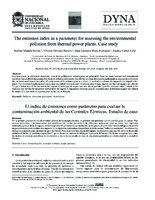 El índice de emisiones como parámetro para evaluar la contaminación ambiental de las Centrales Térmicas. Estudio de caso
El índice de emisiones como parámetro para evaluar la contaminación ambiental de las Centrales Térmicas. Estudio de caso En las plantas generadoras de electricidad, además de la energía eléctrica, se generan contaminantes del aire por los gases de escape. Hay normas nacionales e internacionales que establecen los límites permisibles de diferentes sustancias, pero no existe una expresión matemática para evaluar el impacto ambiental producido por todos los componentes de los gases como un todo. En este trabajo se desarrolla un procedimiento para evaluar este impacto. A la expresión matemática desarrollada se le denominó "índice de emisiones". Se ofrecen los índices de emisiones para motores de gas y de Fueloil. Para tener una idea exacta del impacto ambiental de cada tipo de motor se desarrolló también el "índice de emisiones específicas", que es la tasa de emisión dividida por la potencia del motor. Se ofrecen comparaciones entre los índices de emisión específicos de los motores a través de un estudio de caso de una planta generadora de electricidad en la ciudad de Manaus.
-
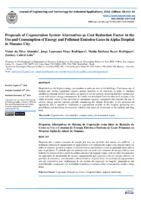 Proposals of Cogeneration System Alternatives as Cost Reduction Factor in the Use and Consumption of Energy and Pollutant Emission Gases in Alpha Hospital in Manaus City
Proposals of Cogeneration System Alternatives as Cost Reduction Factor in the Use and Consumption of Energy and Pollutant Emission Gases in Alpha Hospital in Manaus City Hospitals have the highest energy consumption in units per area in the buildings. Continuous use of
heating and cooling equipment requires greater attention in all directions in order to maintain
satisfactory thermal comfort and indoor air quality levels for patients. Knowing that this structure has
a cost with electric energy consumption, this work was developed from the structural analysis of the
Alpha hospital, where it was surveyed its attendance capacity, equipment that requires the use of
electric energy and the consume periods, considering the climate. From this, it was analyzed the
equipment that is needed to implement a cogeneration module in the hospital, proposing two
possibilities and analyzing its economic viability and return on investment in the medium and long
term.
-
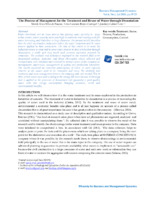 The Process of Managment for the Treatment and Reuse of Water through Decantation
The Process of Managment for the Treatment and Reuse of Water through Decantation Water treatment and its reuse process has gaining space specially in large
urban centers where scarcity represents high investments and running costs for
water harvesting and abduction at large distances. The present article describes
how the civil construction industries realize the water treatment and its reuse
process applied in their production. The aim of this article is to make the
industries aware to treat and to reuse water present in their production through
decantation, a viable and very much used resource currently assumed by
companies. The methods and techniques employed in the research field were:
documental analysis, interview and direct observation where collected and
analyzed data were tabulated and reviewed in several sectors of the company as:
management, supervision, management of quality and production laboratory.
The results consisted on conscious consumption of water, in most rigorous
controls to the means used in its treatment and reuse. By adopting that
treatment and reuse management process the company will save around 70% to
80% of that water reuse and a saving in the energy bill since the new technology
that is applied in the processes of decantation will guarantee a good quality
water with low energy consumption bringing economic, social and
environmental benefits.
-
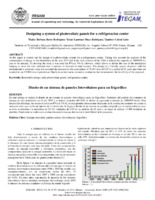 Designing a system of photovoltaic panels for a refrigeracion center
Designing a system of photovoltaic panels for a refrigeracion center At this paper is carried out the design of a photovoltaic system for a refrigeracion center. Taking into account the analysis of the
consumption of energy of this installation in the year 2015 and at the first semester of the 2016 is defined the capacity of 2000MW-h /
year to be instaled. To develop the work it was used the PVsyst V6.42 software, which allows to define the size of the installation
keeping in mind the solar radiation that it receives in function of their location. The design of a friendly system of panels with the
environment is achieved, since it is avoided the emission to the atmosphere of 38 451 tons of CO2 in a period of 25 years and there are
avoided to use 13 800 tons of petroleum. Finally is carried out an economic evaluation that demonstrates the feasibility of the proposal.
-
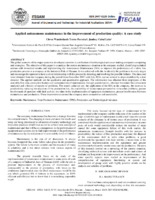 Applied autonomous maintenance in the improvement of production quality: A case study
Applied autonomous maintenance in the improvement of production quality: A case study The global scenario of the major economic developed countries is a reflection of technological advances making companies competing
and strategists. The objective of this paper is to analyze the current maintenance situation at the company studied, identifying technical
actions with immediate results and implementing the Autonomous Maintenance (MA) to improve the performance of a white line
production process in a company at the Industrial Pole of Manaus. It was achieved with this, to identify the problem in its early stages
and encourage the operator to have a closer relationship with his process by detecting and resolving the possible failures. The data used
were obtained from the company during the period from December 2015 until July 2016, and are related to stops identified by a leak
detector. The applied methods are the qualitative and quantitative approach. The information was obtained from employees of the
assembly line area, production leaders and representatives of maintenance, through questionnaires, obtained from data files (document
analysis) and a history of reports of problems. The results achieved are: the application of the MA in the company, the increase in
productivity; reducing the stop time of the production line, the availability of maintenance personnel to solve other problems, greater
involvement of operators with their activity, less time in the implementation of equipment maintenance; greater involvement between
maintenance and production. These improvements turned the company more competitive and sustainable.
-
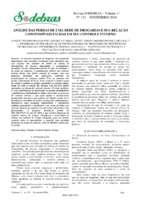 ANÁLISE DAS PERDAS DE UMA REDE DE DROGARIAS E SUA RELAÇÃO COM POSSÍVEIS FALHAS EM SEU CONTROLE INTERNO
ANÁLISE DAS PERDAS DE UMA REDE DE DROGARIAS E SUA RELAÇÃO COM POSSÍVEIS FALHAS EM SEU CONTROLE INTERNO O mercado brasileiro de drogarias vem ganhando
importância como atividade econômica, pelas dimensões que
este negócio vem tomando em termos de volume de
faturamento, de pessoas empregadas e consumidores
atendidos. Porém, independentemente do tipo de atividade e
do porte da empresa, é fundamental manter um controle
interno eficaz, com efetivo controle de estoque, visto que
pequenos descuidos nas aplicações, controles ou
programações de estoques, podem levar ao aumento das
perdas e diminuição do lucro. Neste contexto, o objetivo geral
do estudo é analisar as perdas registradas no período citado,
tendo em vista a relação das mesmas com possíveis falhas
apontadas no sistema de controle interno. O estudo justificase pela contribuição de apresentar as perdas quantitativas
e qualitativas, explicitando as falhas observadas no processo
de controle interno, o que pode ajudar a minimizá-las,
promovendo um lucro que poderia em última escala, vir a
beneficiar a sociedade no tocante ao preço dos medicamentos.
Realizou-se uma pesquisa exploratória e explicativa,
análises quantitativa e qualitativa, com coleta de dados por
meio de registros da empresa e de entrevistas não formais com
funcionários. A pesquisa identificou perdas de
R$1.206.075,97 no ano de 2014, o que revelou fraquezas do
controle interno de estoque. Identificou a necessidade de
utilizar um controle de estoque adequado, para um melhor
controle sobre as mercadorias, e torná-lo uma atividade
freqüente na rotina da empresa, a fim de diminuir ainda mais
as perdas.
-
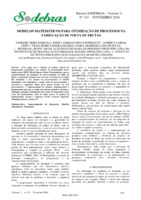 MODELOS MATEMÁTICOS PARA OTIMIZAÇÃO DE PROCESSOS NA FABRICAÇÃO DE POLPA DE FRUTAS
MODELOS MATEMÁTICOS PARA OTIMIZAÇÃO DE PROCESSOS NA FABRICAÇÃO DE POLPA DE FRUTAS Este artigo tem o objetivo de propor, através de
programação matemática, um modelo, de programação linear
inteira mista MILP (Mixed Integer Linear Programming), para o
sequenciamento de produção no processamento de polpa de
frutas, envolvendo restrições nos recursos, na ordem de execução
das atividades e nos tempos de processamento. O modelo
matemático visa minimizar o tempo total de processamento e
encontrar a sequência ótima para quatro tarefas em três
processadores. A implementação de sistemas computacionais é
fundamental para que se tenha um sistema produtivo eficiente e
otimizado, gerando a diminuição dos custos de transporte e hora
extra dos funcionários, além de obter lucros. O modelo foi
implementado usando o software GAMS (General Algebraic
Modeling System), versão 23.7.
-
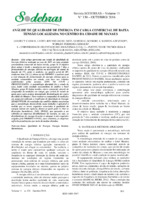 ANÁLISE DE QUALIDADE DE ENERGIA EM CARGA COMERCIAL DE BAIXA TENSÃO LOCALIZADA NO CENTRO DA CIDADE DE MANAUS
ANÁLISE DE QUALIDADE DE ENERGIA EM CARGA COMERCIAL DE BAIXA TENSÃO LOCALIZADA NO CENTRO DA CIDADE DE MANAUS Este artigo apresenta um estudo de Qualidade de
Energia Elétrica realizado no ano de 2015 em uma unidade
consumidora comercial de baixa tensão, grupo B. O objetivo
deste artigo é medir e monitorar por um período de 7 dias o
fornecimento de energia elétrica na derivação do ramal de
ligação da UC, junto à medição, no quadro geral de BT,
conforme item 2.6.1.5, alínea (a) do PRODIST e analisar qual
a real situação do fornecimento de energia elétrica para as
unidade consumidora em estudo, com base nos critérios
estabelecidos pelas normas, IEEE Std 519-92 e
PRODIST/ANEEL. A metodologia abordada foi o estudo de
caso, tendo como unidade consumidora de análise o hotel
Manáos, grupo B (baixa tensão), classe comercial, através de
campanhas de medições em campo, que servirá de estudo de
apoio para outro projeto denominado Revitalização do centro
da cidade de Manaus. Para realizar as campanhas de medições
em campo foi utilizado o Analisador de Qualidade de Energia
HIOKI PW3198. Os resultados das análises obtidos mostraram
que a metodologia desenvolvida neste trabalho é aplicável à
medida que os novos requisitos associados à qualidade da
energia entrem em vigência, dentre os quais pode se citar as
distorções harmônicas, SAG, SWELL, que passarão a ser
cobrados às empresas distribuidoras de energia, ou seja, as
distribuidoras de energia deverão se adequar a tais requisitos
exigidos pelo PRODIST/ANEEL, caso contrário, as empresas
sofrerão penalizações por meio de multas elevadas.
-
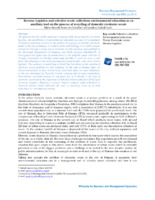 Reverse Logistics and selective waste collection: environmental education as an auxiliary tool on the process of recycling of domestic electronic waste
Reverse Logistics and selective waste collection: environmental education as an auxiliary tool on the process of recycling of domestic electronic waste The general objective of this work was to analyze from the perspective of reverse
logistics, the contribution of environmental education as a tool of management
of selective collection of waste in the context of recycling of domestic electronic
waste in the city of Manaus. In relation of the methodology, it is a field research
carried out through a study case at Descarte Correto company, accomplished in
the Municipal Department of Cleaning and Public Services (SEMULSP, in
Portuguese) and application of questionnaire to 16 reclyable waste collectors of
Aliança Cooperative in Manaus, what made possible to reach the aims of this
work, also focusing on the environmental and social benefits came from reverse
logistics. The outcomes revealed that in Brazil the iniciatives to the solution of
electronic waste problem are still incipient. In the city of Manaus then are
almost nonexistent. In fact, at local level, what takes place are some initiatives,
as the ones developed by Descarte Correto company and of some cooperatives.
Nevertheless, manauara society are not aware yet, as it should, to the issue of
electronic waste and to the importance of Selective Waste Collection (SWC) and
of reverse logistics. Therefore, it proved, despite incipient, some individual or
corporate actions which addresses the issue of electronic waste as of vital
importance in contemporary society.
-
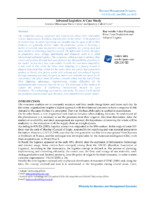 Inbound Logistics: A Case Study. Business Management Dynamics
Inbound Logistics: A Case Study. Business Management Dynamics The competition among companies and corporations forces them continually
seek for improvements to achieve and keep place in the market. In the dynamism
of current time, in which big brands are unstable and the cycle of life of their
products are gradually shorter, adapt the production means is becoming a
matter of survival, once the products among competitors are getting more and
more similar, in technology and price as well. The differential consists, therefore,
in production costs, storage, distribution and transport, what it is called
inbound and outbound logistics. The companies, which are able to optimize their
service and produce through lean manufacturer, has the possibility of putting in
the market, in fact short time, new models. To make the costs more competitive,
it was used in this study the Value Flow Mapping in a factory located in
Manaus Industrial Pole, which has the main clients two wheels that automakers
produce in Brazil. This factory works with national and international logistic,
through waterway and road transport, to import raw material and inputs for its
end product. The article about dissertates concepts which base the tool of Value
Flow Mapping, advantages, improvements, besides difficulties for its
implantation and necessary steps for its use. The main goal of this study is to
sustain the process of continuing improvement, focused on Lean
Production. The methodology used was the case study. The result it will reached
the productive process leaner and, therefore, more competitive for global market
-
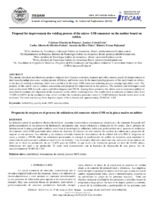 Proposal for improvement the welding process of the micro- USB connector on the mother board on tablets
Proposal for improvement the welding process of the micro- USB connector on the mother board on tablets The current electrical and electronic products industry have features extremely dynamic and with constant search for improvement in
their manufacturing processes, seeking greater efficiency and lower costs. In the manufacturing process of the main board on tablets,
in the area of welding technology, there was a problem in the micro USB connector soldering process causing high defect rates. The
purpose of this article was to conduct assessment and proposal for improvement in this process. The methods and techniques used
were quality tools PDCA cycle, cause and effect diagram and 5W2H. Among these solutions, the choice was to implement pallets of
durestone to maintain the alignment of the connector on the reflow soldering oven. The results show a reduction in failure rates from
12.40% to 0.09% in the production line, which avoided the institution generate a total of 24,800 defective boards on the total to be
produced. The total cost savings from logistics repair of these boards was approximately 70.002,80. USD
-
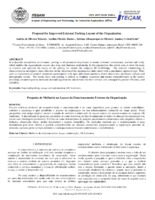 Proposal for Improved External Parking Layout of the Organization
Proposal for Improved External Parking Layout of the Organization In a dynamic competitive environment, parking is of paramount importance to ensure customer convenience, comfort and safety
which enables the organization's success in a long-term business relationship. In this perspective, this article aims to show the study
to improve and optimize the layout of the parking lot outside the company JB Scaffolding. The research methodology is
characterized as descriptive, data collection on the situation of the organization under study with a quantitative approach type. Were
used as instruments of research structured questionnaire with open and closed questions, direct observation, document analysis and
photographic record. The results show that parking is critical to retaining customers and ensure competitiveness in the market
providing consumers part to increased demand organization and demand for their services and consequently greater efficiency and
reliability.
-
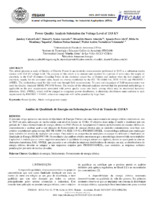 Power Quality Analysis Substation the Voltage Level of 13.8 KV
Power Quality Analysis Substation the Voltage Level of 13.8 KV This article presents a study of Quality of Electric Power in an electricity concessionaire performed in 2015 at a substation media
tension with 13.8 kV voltage level. The purpose of this article is to measure and monitor for a period of seven days the supply of
electricity in the CAP (Common Coupling Point) in the electrical system bus of Dealers and analyze what the real situation of
electricity supply for the consumer units, based on criteria established by the IEC TR 61000-3-6, IEEE 519-92 and PRODIST /
ANEEL. The methodology used for this work was through field measurements. To carry out campaigns of field measurements was
used the Quality Analyzer HIOKI PW3198 Power. The results of the obtained analyzes showed that the presented methodology is
applicable as the new requirements associated with power quality come into force, among which may be mentioned harmonic
distortion, SAG, SWELL, which will be charged to companies power distribution, ie electricity distributors must conform to such
requirements by PRODIST / ANEEL, otherwise companies will suffer penalties by large fines.
-
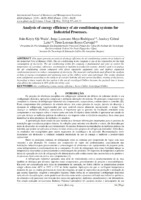 Analysis of energy efficiency of air conditioning systems for Industrial Processes
Analysis of energy efficiency of air conditioning systems for Industrial Processes :The paper presents an analysis of energy efficiency in air conditioning systems in an industry of
the Industrial Polo of Manaus (PIM). The air conditioning in the company is one of the responsible for the high
consumption of electricity. The air conditioning within the company is fundamental and aims to control the
temperature of a product, substance, environment or medium in production systems. Article's goal is to analyze
the air conditioning system compared with direct expansion equipment (air) and indirect expansion
condensation (water) to reduce consumption of electricity. The materials and methods used allowed the analysis
of data of energy consumption and operating costs of the chillers screw and centrifugal. The results obtained
were satisfactory according to the analysis of costs for both the old and current facilities, existing at the factory.
According to these results the best option is the use of centrifugal Chillers because the payback time is lesser,
also allows the reduction in 40% of the electricity costs
-
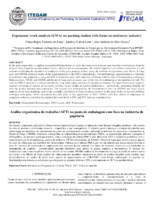 Ergonomic work analysis (EWA) no packing station with focus on stationery industry
Ergonomic work analysis (EWA) no packing station with focus on stationery industry In the study ergonomics is applied occupational biomechanics to study the interactions between man-machine environment, from the
point of view of posture and movement muscle - skeletal and its consequence. The overall objective is to achieve a reduction of work
without overloading the members of employees of the pens packing station, using the methods of ergonomics and Moore & Garg
tools and NIOSH, achieved results of the implementation of the PDCA methodology. The methodology applied research is literature
of qualitative and quantitative, using the PDCA method to direct AET and solve problems with the help of brainstorning techniques,
Ishikawa chart, 5W2H and NIOSH and Moore & Garg tools to assess task of the risk of overloading to the members of staff. We
used the PDCA method is a method that has the same philosophy and focus of ergonomics interest, the implementation of systems,
together consisting of sources of successes, reverses on the results of comfort performance - productivity, generating benefits for
both the parties, business and employees. The success was evidenced by the revaluation of tasks by NIOSH tool (load survey
analysis on the task of putting cash on the treadmill) and Moore & Garg (overhead analysis in the upper limbs on the task of filling
cartridges with pens), which potentiated low-risk tasks as the appearance of RSI / MSDs; with low claims of employees of
complaints related to activities that reached the lower level to 50% and 20% increase in productivity.
-
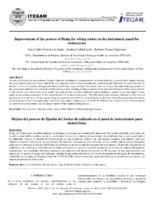 Improvement of the process of fixing the wiring socket on the instrument panel for motorcycles
Improvement of the process of fixing the wiring socket on the instrument panel for motorcycles The use of Sockets for preparation of lamps, either for residential or industrial use, has been suffering a considerable change through
the years their its physical model and in the raw material used for their manufacture, motivating the industries to search amodel of
Socket in favor of a quality management and a continuous improvement. This article aims to analyze the manufacturing process of
the instrument panel for two-wheeled vehicle (motorcycles), looking for improvements in the process of fixation of the wiring Socket
in the inferior case of the instrument panel. The used method was the qualitative and quantitative, guided by the technique of case
study in the production process of the assembly line of the instrument panel. The obtained results showed a reduction in the time of
the process from 40 sec to 16 sec, representing an improvement of 24 sec in the indicator of the time, beyond a direct reduction in the
production cost of the instrument panel, resulting in an annual financial gain of (U$D 40.794,46) with a return of the invested capital
in a period of seven months, and the improvement of the manufacturing process.
-
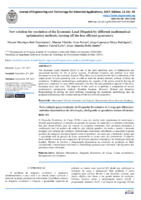 New solution for resolution of the Economic Load Dispatch by different mathematical optimization methods, turning off the less efficient generators
New solution for resolution of the Economic Load Dispatch by different mathematical optimization methods, turning off the less efficient generators The Economic Load Dispatch (ELD) is one of the most important tasks of optimization and
operational decision for the in power systems. Traditional materials and methods have been
developed to solve the economic dispatch. They allow you to determine the ideal combination of the
output power of each generating unit, in order to meet the desired demand, without violating the
restrictions. Traditional methodologies underutilize the capacity of the power plant by leaving all
generators connected, in cases where demand is less than the total generation capacity of the plant,
increasing total fuel costs. The objective of this work is to perform a comparison of several
mathematical optimization methods (Lambda Iteration, Newton's Method and Quadratic
Programming) in solving the ELD problem, considering the traditional methodology and the
proposed methodology that includes turning off the less efficient generators.
-
 Cultural algorithm with local search evaluated through non-parametric statistical tests
Cultural algorithm with local search evaluated through non-parametric statistical tests This work aims to analyze the performance of the classical Cultural Algorithm (CA) with a new
hybrid CA proposal with to two local search techniques (Simulated Annealing - SA and Tabu
Search - TS). In order to diversify the tests, in the CA with SA there was variation of the parameter
energy, and in the CA with TS, there was variation in the size of the tabu list. The algorithms were
submitted to two scenarios (scenario 1 - Basic functions, scenario 2 - Hybrid functions). The
proposed algorithm differs from others found in the literature, by the process of feeding the
topographic knowledge that guides the research. The analysis was performed using the Friedman,
Friedman Aligned and Quades tests, which serve to compare the behavior of a set of algorithms at
one time.
-
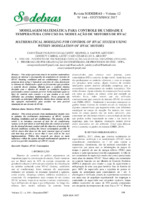 MATHEMATICAL MODELING FOR CONTROL OF HVAC SYSTEM USING WITHIN MODELATION OF HVAC MOTORS
MATHEMATICAL MODELING FOR CONTROL OF HVAC SYSTEM USING WITHIN MODELATION OF HVAC MOTORS Este artigo apresenta através de modelos matemáticos
formas de otimizar o desempenho da arquitetura de sistemas de
HVAC (heating, ventilation and air conditioning). A primeira
proposta deste artigo é introduzir conceitos de como funcionam
os sistemas de climatização e quais as ferramentas que permitem
o controle desses sistemas olhando para o conforto térmico
desejado com o objetivo de atender as condições desejáveis
procurando o menor consumo possível. Serão mostrados quais os
tipos de controle mais comuns e os que tendem a ser mais
utilizados nas proximas implementações. Nessa pesquisa são
mostradas as principais influências dentro desse sistema através
das equações matemáticas para auxiliar em uma possível
simulação de um circuito de HVAC
-
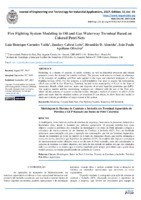 Fire Fighting System Modeling in Oil and Gas Waterway Terminal Based on Colored Petri Nets
Fire Fighting System Modeling in Oil and Gas Waterway Terminal Based on Colored Petri Nets Modeling, as a means of analysis of safety systems, as well as industrial processes and related
purposes, meets the demand for suitable methods. The present work aims to evaluate an adherence
of the concepts of modeling and Petri nets applied to the logic and interlock strategies of a Fire
Fighting System (FFS). For this purpose, a real installation was used to acquire the information,
which was an Oil & Gas Waterway Terminal, located in the municipality of Coari in the State of
Amazonas, Brazil, which receives, stores and disposes of oil and liquefied petroleum gas (LPG).
The analysis models and the interlocking strategies are validated with the use of the Petri nets,
where are the patterns of systems to discrete events, through a method of analysis in which all the
paths and states that the modeled system are simulated It can obtain, to allow from this model to
study and evaluate possibilities of improvement of the system
-
 Home Automation with Web Control Based on Java Applets
Home Automation with Web Control Based on Java Applets The purpose of this work is to present concepts of systems integration, involving the computational,
electronic, civil and mechanical areas directed to domotics and the benefits it brings, focused on the
remote control performed through the Internet. Addressing Web programming with the use of Java
applets, and other technologies involved in implementing Internet integration with automated
residence. By demonstrating how it is possible through a web browser to control automated home
systems, allied with the increasing demand for home automation products. They are systems that allow
the lighting of lights by means of sensors, automatic climate control, cameras integrated in the rooms
besides many other equipment. Where the proposed system includes lighting control functions, using
switches that allow the control of light intensity, which allows the implementation of scenarios with
scenic lighting. With this in mind, it was necessary to study the electric circuit of lighting, covering
types of peripheral controllers and the models of the dimmer switches that allow the functionalities
that the application requires.
-
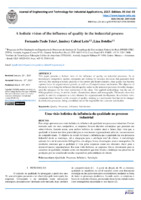 A HOLISTIC VISION OF THE INFLUENCE OF QUALITY IN THE INDUSTRIAL PROCESS
A HOLISTIC VISION OF THE INFLUENCE OF QUALITY IN THE INDUSTRIAL PROCESS This paper presents a holistic view of the influence of quality on industrial processes. In an
increasingly competitive market, companies are looking for strategic decisions that guarantee their
survival, thus making a holistic analysis of the current and future scenario, since quality has become
a prime factor for organizational growth, as well as a Competitiveness mechanism. The objective of
the study was to bring the influence that the quality makes in the industrial processes from the changes,
until the adequacy for the total satisfaction of the client. The applied methodology was the one of
bibliographical survey, in articles, books, dissertations, theses and monographs. The results show that
quality is seen by companies as a key element for organizational development. In a holistic view,
companies have focused on the concepts of quality, treating as a mechanism that has led to changes
in production processes, being considered one of the responsible for customer satisfaction.
-
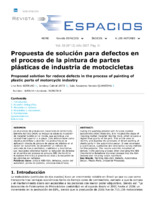 Propuesta de solución para defectos en el proceso de la pintura de partes plásticas de industria de motocicletas
Propuesta de solución para defectos en el proceso de la pintura de partes plásticas de industria de motocicletas During the painting process with Acrylate styrene
acrylonitrile (ASA) materials, it is included the stage of
injecting molten material into the mold, which ensures a
higher final quality of the part. This article aims to
identify and describe the problems of direct painting of
plastic parts in the automotive sector. It was developed
a quantitative, qualitative and descriptive survey method
for this porpoise. The results were the reduction of
defects in the painting process when changing the ABS
(Acrylonitrile Butadiene Styrene) process into the ASA
process and reducing losses rejections.
 Environmental and economic impact of the use of natural gas for generating electricity in The Amazon: A case study Las transformaciones que tienen lugar en el Amazonas, considerado "el pulmón del planeta", tienen un significado especial, no solamente por el ahorro de energía, sino también por su impacto ambiental debido a la reducción de gases de efecto invernadero. Desde el año 2010, en Manaos la capital del Amazonas en Brasil, muchas centrales termoeléctricas están sustituyendo el fueloil por gas natural para la generación de energía. Debido a la gran reserva de gas natural en la región, este combustible se ha convertido en la mejor opción para las centrales eléctricas construidas en este lugar. En el presente trabajo se analiza el impacto técnico económico y medio ambiental de la sustitución del fueloil por el gas natural en la planta de generación de energía analizada.
Environmental and economic impact of the use of natural gas for generating electricity in The Amazon: A case study Las transformaciones que tienen lugar en el Amazonas, considerado "el pulmón del planeta", tienen un significado especial, no solamente por el ahorro de energía, sino también por su impacto ambiental debido a la reducción de gases de efecto invernadero. Desde el año 2010, en Manaos la capital del Amazonas en Brasil, muchas centrales termoeléctricas están sustituyendo el fueloil por gas natural para la generación de energía. Debido a la gran reserva de gas natural en la región, este combustible se ha convertido en la mejor opción para las centrales eléctricas construidas en este lugar. En el presente trabajo se analiza el impacto técnico económico y medio ambiental de la sustitución del fueloil por el gas natural en la planta de generación de energía analizada. ALGORITMO PARA LA CREACIÓN DEL MODELO ALÁMBRICO DE UN TECHO FIJO PARA TANQUE DE ALMACENAMIENTO DE COMBUSTIBLE EN FORMA DE DOMO GEODÉSICO ESFÉRICO Un domo geodésico es una malla de barras y nudos dispuestos según las aristas y vértices de un poliedro inscrito en una superficie que puede presentar forma de esfera, parábola o elipse. A partir de conocerse las ventajas de este tipo de estructura han sido ampliamente usadas en diferentes construcciones como: viviendas, oficinas comerciales, invernaderos, stand de ferias, techos fijos de tanques de almacenamiento de combustible, entre otras. Muchos son los investigadores que han estudiado la modelación y geometría de los domos geodésicos, el enfoque y objetivo del presente trabajo es presentar, a partir de la revisión y recopilación de informaciones de varias investigaciones un algoritmo para generación de un modelo alámbrico de un domo geodésico esférico para techos fijos de tanques de almacenamiento de combustible, para su posterior análisis de resistencia por el método de los elementos finitos. En el trabajo se exponen de forma detallada el procedimiento y las expresiones geométricas empleadas. Finalmente, fue elaborado un programa computacional con la finalidad de evaluar las expresiones matemáticas y el procedimiento descripto en el trabajo y de disponer de una herramienta computacional para la generación del modelo alámbrico de un domo geodésico esférico.
ALGORITMO PARA LA CREACIÓN DEL MODELO ALÁMBRICO DE UN TECHO FIJO PARA TANQUE DE ALMACENAMIENTO DE COMBUSTIBLE EN FORMA DE DOMO GEODÉSICO ESFÉRICO Un domo geodésico es una malla de barras y nudos dispuestos según las aristas y vértices de un poliedro inscrito en una superficie que puede presentar forma de esfera, parábola o elipse. A partir de conocerse las ventajas de este tipo de estructura han sido ampliamente usadas en diferentes construcciones como: viviendas, oficinas comerciales, invernaderos, stand de ferias, techos fijos de tanques de almacenamiento de combustible, entre otras. Muchos son los investigadores que han estudiado la modelación y geometría de los domos geodésicos, el enfoque y objetivo del presente trabajo es presentar, a partir de la revisión y recopilación de informaciones de varias investigaciones un algoritmo para generación de un modelo alámbrico de un domo geodésico esférico para techos fijos de tanques de almacenamiento de combustible, para su posterior análisis de resistencia por el método de los elementos finitos. En el trabajo se exponen de forma detallada el procedimiento y las expresiones geométricas empleadas. Finalmente, fue elaborado un programa computacional con la finalidad de evaluar las expresiones matemáticas y el procedimiento descripto en el trabajo y de disponer de una herramienta computacional para la generación del modelo alámbrico de un domo geodésico esférico. El índice de emisiones como parámetro para evaluar la contaminación ambiental de las Centrales Térmicas. Estudio de caso En las plantas generadoras de electricidad, además de la energía eléctrica, se generan contaminantes del aire por los gases de escape. Hay normas nacionales e internacionales que establecen los límites permisibles de diferentes sustancias, pero no existe una expresión matemática para evaluar el impacto ambiental producido por todos los componentes de los gases como un todo. En este trabajo se desarrolla un procedimiento para evaluar este impacto. A la expresión matemática desarrollada se le denominó "índice de emisiones". Se ofrecen los índices de emisiones para motores de gas y de Fueloil. Para tener una idea exacta del impacto ambiental de cada tipo de motor se desarrolló también el "índice de emisiones específicas", que es la tasa de emisión dividida por la potencia del motor. Se ofrecen comparaciones entre los índices de emisión específicos de los motores a través de un estudio de caso de una planta generadora de electricidad en la ciudad de Manaus.
El índice de emisiones como parámetro para evaluar la contaminación ambiental de las Centrales Térmicas. Estudio de caso En las plantas generadoras de electricidad, además de la energía eléctrica, se generan contaminantes del aire por los gases de escape. Hay normas nacionales e internacionales que establecen los límites permisibles de diferentes sustancias, pero no existe una expresión matemática para evaluar el impacto ambiental producido por todos los componentes de los gases como un todo. En este trabajo se desarrolla un procedimiento para evaluar este impacto. A la expresión matemática desarrollada se le denominó "índice de emisiones". Se ofrecen los índices de emisiones para motores de gas y de Fueloil. Para tener una idea exacta del impacto ambiental de cada tipo de motor se desarrolló también el "índice de emisiones específicas", que es la tasa de emisión dividida por la potencia del motor. Se ofrecen comparaciones entre los índices de emisión específicos de los motores a través de un estudio de caso de una planta generadora de electricidad en la ciudad de Manaus. Proposals of Cogeneration System Alternatives as Cost Reduction Factor in the Use and Consumption of Energy and Pollutant Emission Gases in Alpha Hospital in Manaus City Hospitals have the highest energy consumption in units per area in the buildings. Continuous use of heating and cooling equipment requires greater attention in all directions in order to maintain satisfactory thermal comfort and indoor air quality levels for patients. Knowing that this structure has a cost with electric energy consumption, this work was developed from the structural analysis of the Alpha hospital, where it was surveyed its attendance capacity, equipment that requires the use of electric energy and the consume periods, considering the climate. From this, it was analyzed the equipment that is needed to implement a cogeneration module in the hospital, proposing two possibilities and analyzing its economic viability and return on investment in the medium and long term.
Proposals of Cogeneration System Alternatives as Cost Reduction Factor in the Use and Consumption of Energy and Pollutant Emission Gases in Alpha Hospital in Manaus City Hospitals have the highest energy consumption in units per area in the buildings. Continuous use of heating and cooling equipment requires greater attention in all directions in order to maintain satisfactory thermal comfort and indoor air quality levels for patients. Knowing that this structure has a cost with electric energy consumption, this work was developed from the structural analysis of the Alpha hospital, where it was surveyed its attendance capacity, equipment that requires the use of electric energy and the consume periods, considering the climate. From this, it was analyzed the equipment that is needed to implement a cogeneration module in the hospital, proposing two possibilities and analyzing its economic viability and return on investment in the medium and long term. The Process of Managment for the Treatment and Reuse of Water through Decantation Water treatment and its reuse process has gaining space specially in large urban centers where scarcity represents high investments and running costs for water harvesting and abduction at large distances. The present article describes how the civil construction industries realize the water treatment and its reuse process applied in their production. The aim of this article is to make the industries aware to treat and to reuse water present in their production through decantation, a viable and very much used resource currently assumed by companies. The methods and techniques employed in the research field were: documental analysis, interview and direct observation where collected and analyzed data were tabulated and reviewed in several sectors of the company as: management, supervision, management of quality and production laboratory. The results consisted on conscious consumption of water, in most rigorous controls to the means used in its treatment and reuse. By adopting that treatment and reuse management process the company will save around 70% to 80% of that water reuse and a saving in the energy bill since the new technology that is applied in the processes of decantation will guarantee a good quality water with low energy consumption bringing economic, social and environmental benefits.
The Process of Managment for the Treatment and Reuse of Water through Decantation Water treatment and its reuse process has gaining space specially in large urban centers where scarcity represents high investments and running costs for water harvesting and abduction at large distances. The present article describes how the civil construction industries realize the water treatment and its reuse process applied in their production. The aim of this article is to make the industries aware to treat and to reuse water present in their production through decantation, a viable and very much used resource currently assumed by companies. The methods and techniques employed in the research field were: documental analysis, interview and direct observation where collected and analyzed data were tabulated and reviewed in several sectors of the company as: management, supervision, management of quality and production laboratory. The results consisted on conscious consumption of water, in most rigorous controls to the means used in its treatment and reuse. By adopting that treatment and reuse management process the company will save around 70% to 80% of that water reuse and a saving in the energy bill since the new technology that is applied in the processes of decantation will guarantee a good quality water with low energy consumption bringing economic, social and environmental benefits. Designing a system of photovoltaic panels for a refrigeracion center At this paper is carried out the design of a photovoltaic system for a refrigeracion center. Taking into account the analysis of the consumption of energy of this installation in the year 2015 and at the first semester of the 2016 is defined the capacity of 2000MW-h / year to be instaled. To develop the work it was used the PVsyst V6.42 software, which allows to define the size of the installation keeping in mind the solar radiation that it receives in function of their location. The design of a friendly system of panels with the environment is achieved, since it is avoided the emission to the atmosphere of 38 451 tons of CO2 in a period of 25 years and there are avoided to use 13 800 tons of petroleum. Finally is carried out an economic evaluation that demonstrates the feasibility of the proposal.
Designing a system of photovoltaic panels for a refrigeracion center At this paper is carried out the design of a photovoltaic system for a refrigeracion center. Taking into account the analysis of the consumption of energy of this installation in the year 2015 and at the first semester of the 2016 is defined the capacity of 2000MW-h / year to be instaled. To develop the work it was used the PVsyst V6.42 software, which allows to define the size of the installation keeping in mind the solar radiation that it receives in function of their location. The design of a friendly system of panels with the environment is achieved, since it is avoided the emission to the atmosphere of 38 451 tons of CO2 in a period of 25 years and there are avoided to use 13 800 tons of petroleum. Finally is carried out an economic evaluation that demonstrates the feasibility of the proposal. Applied autonomous maintenance in the improvement of production quality: A case study The global scenario of the major economic developed countries is a reflection of technological advances making companies competing and strategists. The objective of this paper is to analyze the current maintenance situation at the company studied, identifying technical actions with immediate results and implementing the Autonomous Maintenance (MA) to improve the performance of a white line production process in a company at the Industrial Pole of Manaus. It was achieved with this, to identify the problem in its early stages and encourage the operator to have a closer relationship with his process by detecting and resolving the possible failures. The data used were obtained from the company during the period from December 2015 until July 2016, and are related to stops identified by a leak detector. The applied methods are the qualitative and quantitative approach. The information was obtained from employees of the assembly line area, production leaders and representatives of maintenance, through questionnaires, obtained from data files (document analysis) and a history of reports of problems. The results achieved are: the application of the MA in the company, the increase in productivity; reducing the stop time of the production line, the availability of maintenance personnel to solve other problems, greater involvement of operators with their activity, less time in the implementation of equipment maintenance; greater involvement between maintenance and production. These improvements turned the company more competitive and sustainable.
Applied autonomous maintenance in the improvement of production quality: A case study The global scenario of the major economic developed countries is a reflection of technological advances making companies competing and strategists. The objective of this paper is to analyze the current maintenance situation at the company studied, identifying technical actions with immediate results and implementing the Autonomous Maintenance (MA) to improve the performance of a white line production process in a company at the Industrial Pole of Manaus. It was achieved with this, to identify the problem in its early stages and encourage the operator to have a closer relationship with his process by detecting and resolving the possible failures. The data used were obtained from the company during the period from December 2015 until July 2016, and are related to stops identified by a leak detector. The applied methods are the qualitative and quantitative approach. The information was obtained from employees of the assembly line area, production leaders and representatives of maintenance, through questionnaires, obtained from data files (document analysis) and a history of reports of problems. The results achieved are: the application of the MA in the company, the increase in productivity; reducing the stop time of the production line, the availability of maintenance personnel to solve other problems, greater involvement of operators with their activity, less time in the implementation of equipment maintenance; greater involvement between maintenance and production. These improvements turned the company more competitive and sustainable. ANÁLISE DAS PERDAS DE UMA REDE DE DROGARIAS E SUA RELAÇÃO COM POSSÍVEIS FALHAS EM SEU CONTROLE INTERNO O mercado brasileiro de drogarias vem ganhando importância como atividade econômica, pelas dimensões que este negócio vem tomando em termos de volume de faturamento, de pessoas empregadas e consumidores atendidos. Porém, independentemente do tipo de atividade e do porte da empresa, é fundamental manter um controle interno eficaz, com efetivo controle de estoque, visto que pequenos descuidos nas aplicações, controles ou programações de estoques, podem levar ao aumento das perdas e diminuição do lucro. Neste contexto, o objetivo geral do estudo é analisar as perdas registradas no período citado, tendo em vista a relação das mesmas com possíveis falhas apontadas no sistema de controle interno. O estudo justificase pela contribuição de apresentar as perdas quantitativas e qualitativas, explicitando as falhas observadas no processo de controle interno, o que pode ajudar a minimizá-las, promovendo um lucro que poderia em última escala, vir a beneficiar a sociedade no tocante ao preço dos medicamentos. Realizou-se uma pesquisa exploratória e explicativa, análises quantitativa e qualitativa, com coleta de dados por meio de registros da empresa e de entrevistas não formais com funcionários. A pesquisa identificou perdas de R$1.206.075,97 no ano de 2014, o que revelou fraquezas do controle interno de estoque. Identificou a necessidade de utilizar um controle de estoque adequado, para um melhor controle sobre as mercadorias, e torná-lo uma atividade freqüente na rotina da empresa, a fim de diminuir ainda mais as perdas.
ANÁLISE DAS PERDAS DE UMA REDE DE DROGARIAS E SUA RELAÇÃO COM POSSÍVEIS FALHAS EM SEU CONTROLE INTERNO O mercado brasileiro de drogarias vem ganhando importância como atividade econômica, pelas dimensões que este negócio vem tomando em termos de volume de faturamento, de pessoas empregadas e consumidores atendidos. Porém, independentemente do tipo de atividade e do porte da empresa, é fundamental manter um controle interno eficaz, com efetivo controle de estoque, visto que pequenos descuidos nas aplicações, controles ou programações de estoques, podem levar ao aumento das perdas e diminuição do lucro. Neste contexto, o objetivo geral do estudo é analisar as perdas registradas no período citado, tendo em vista a relação das mesmas com possíveis falhas apontadas no sistema de controle interno. O estudo justificase pela contribuição de apresentar as perdas quantitativas e qualitativas, explicitando as falhas observadas no processo de controle interno, o que pode ajudar a minimizá-las, promovendo um lucro que poderia em última escala, vir a beneficiar a sociedade no tocante ao preço dos medicamentos. Realizou-se uma pesquisa exploratória e explicativa, análises quantitativa e qualitativa, com coleta de dados por meio de registros da empresa e de entrevistas não formais com funcionários. A pesquisa identificou perdas de R$1.206.075,97 no ano de 2014, o que revelou fraquezas do controle interno de estoque. Identificou a necessidade de utilizar um controle de estoque adequado, para um melhor controle sobre as mercadorias, e torná-lo uma atividade freqüente na rotina da empresa, a fim de diminuir ainda mais as perdas. MODELOS MATEMÁTICOS PARA OTIMIZAÇÃO DE PROCESSOS NA FABRICAÇÃO DE POLPA DE FRUTAS Este artigo tem o objetivo de propor, através de programação matemática, um modelo, de programação linear inteira mista MILP (Mixed Integer Linear Programming), para o sequenciamento de produção no processamento de polpa de frutas, envolvendo restrições nos recursos, na ordem de execução das atividades e nos tempos de processamento. O modelo matemático visa minimizar o tempo total de processamento e encontrar a sequência ótima para quatro tarefas em três processadores. A implementação de sistemas computacionais é fundamental para que se tenha um sistema produtivo eficiente e otimizado, gerando a diminuição dos custos de transporte e hora extra dos funcionários, além de obter lucros. O modelo foi implementado usando o software GAMS (General Algebraic Modeling System), versão 23.7.
MODELOS MATEMÁTICOS PARA OTIMIZAÇÃO DE PROCESSOS NA FABRICAÇÃO DE POLPA DE FRUTAS Este artigo tem o objetivo de propor, através de programação matemática, um modelo, de programação linear inteira mista MILP (Mixed Integer Linear Programming), para o sequenciamento de produção no processamento de polpa de frutas, envolvendo restrições nos recursos, na ordem de execução das atividades e nos tempos de processamento. O modelo matemático visa minimizar o tempo total de processamento e encontrar a sequência ótima para quatro tarefas em três processadores. A implementação de sistemas computacionais é fundamental para que se tenha um sistema produtivo eficiente e otimizado, gerando a diminuição dos custos de transporte e hora extra dos funcionários, além de obter lucros. O modelo foi implementado usando o software GAMS (General Algebraic Modeling System), versão 23.7. ANÁLISE DE QUALIDADE DE ENERGIA EM CARGA COMERCIAL DE BAIXA TENSÃO LOCALIZADA NO CENTRO DA CIDADE DE MANAUS Este artigo apresenta um estudo de Qualidade de Energia Elétrica realizado no ano de 2015 em uma unidade consumidora comercial de baixa tensão, grupo B. O objetivo deste artigo é medir e monitorar por um período de 7 dias o fornecimento de energia elétrica na derivação do ramal de ligação da UC, junto à medição, no quadro geral de BT, conforme item 2.6.1.5, alínea (a) do PRODIST e analisar qual a real situação do fornecimento de energia elétrica para as unidade consumidora em estudo, com base nos critérios estabelecidos pelas normas, IEEE Std 519-92 e PRODIST/ANEEL. A metodologia abordada foi o estudo de caso, tendo como unidade consumidora de análise o hotel Manáos, grupo B (baixa tensão), classe comercial, através de campanhas de medições em campo, que servirá de estudo de apoio para outro projeto denominado Revitalização do centro da cidade de Manaus. Para realizar as campanhas de medições em campo foi utilizado o Analisador de Qualidade de Energia HIOKI PW3198. Os resultados das análises obtidos mostraram que a metodologia desenvolvida neste trabalho é aplicável à medida que os novos requisitos associados à qualidade da energia entrem em vigência, dentre os quais pode se citar as distorções harmônicas, SAG, SWELL, que passarão a ser cobrados às empresas distribuidoras de energia, ou seja, as distribuidoras de energia deverão se adequar a tais requisitos exigidos pelo PRODIST/ANEEL, caso contrário, as empresas sofrerão penalizações por meio de multas elevadas.
ANÁLISE DE QUALIDADE DE ENERGIA EM CARGA COMERCIAL DE BAIXA TENSÃO LOCALIZADA NO CENTRO DA CIDADE DE MANAUS Este artigo apresenta um estudo de Qualidade de Energia Elétrica realizado no ano de 2015 em uma unidade consumidora comercial de baixa tensão, grupo B. O objetivo deste artigo é medir e monitorar por um período de 7 dias o fornecimento de energia elétrica na derivação do ramal de ligação da UC, junto à medição, no quadro geral de BT, conforme item 2.6.1.5, alínea (a) do PRODIST e analisar qual a real situação do fornecimento de energia elétrica para as unidade consumidora em estudo, com base nos critérios estabelecidos pelas normas, IEEE Std 519-92 e PRODIST/ANEEL. A metodologia abordada foi o estudo de caso, tendo como unidade consumidora de análise o hotel Manáos, grupo B (baixa tensão), classe comercial, através de campanhas de medições em campo, que servirá de estudo de apoio para outro projeto denominado Revitalização do centro da cidade de Manaus. Para realizar as campanhas de medições em campo foi utilizado o Analisador de Qualidade de Energia HIOKI PW3198. Os resultados das análises obtidos mostraram que a metodologia desenvolvida neste trabalho é aplicável à medida que os novos requisitos associados à qualidade da energia entrem em vigência, dentre os quais pode se citar as distorções harmônicas, SAG, SWELL, que passarão a ser cobrados às empresas distribuidoras de energia, ou seja, as distribuidoras de energia deverão se adequar a tais requisitos exigidos pelo PRODIST/ANEEL, caso contrário, as empresas sofrerão penalizações por meio de multas elevadas. Reverse Logistics and selective waste collection: environmental education as an auxiliary tool on the process of recycling of domestic electronic waste The general objective of this work was to analyze from the perspective of reverse logistics, the contribution of environmental education as a tool of management of selective collection of waste in the context of recycling of domestic electronic waste in the city of Manaus. In relation of the methodology, it is a field research carried out through a study case at Descarte Correto company, accomplished in the Municipal Department of Cleaning and Public Services (SEMULSP, in Portuguese) and application of questionnaire to 16 reclyable waste collectors of Aliança Cooperative in Manaus, what made possible to reach the aims of this work, also focusing on the environmental and social benefits came from reverse logistics. The outcomes revealed that in Brazil the iniciatives to the solution of electronic waste problem are still incipient. In the city of Manaus then are almost nonexistent. In fact, at local level, what takes place are some initiatives, as the ones developed by Descarte Correto company and of some cooperatives. Nevertheless, manauara society are not aware yet, as it should, to the issue of electronic waste and to the importance of Selective Waste Collection (SWC) and of reverse logistics. Therefore, it proved, despite incipient, some individual or corporate actions which addresses the issue of electronic waste as of vital importance in contemporary society.
Reverse Logistics and selective waste collection: environmental education as an auxiliary tool on the process of recycling of domestic electronic waste The general objective of this work was to analyze from the perspective of reverse logistics, the contribution of environmental education as a tool of management of selective collection of waste in the context of recycling of domestic electronic waste in the city of Manaus. In relation of the methodology, it is a field research carried out through a study case at Descarte Correto company, accomplished in the Municipal Department of Cleaning and Public Services (SEMULSP, in Portuguese) and application of questionnaire to 16 reclyable waste collectors of Aliança Cooperative in Manaus, what made possible to reach the aims of this work, also focusing on the environmental and social benefits came from reverse logistics. The outcomes revealed that in Brazil the iniciatives to the solution of electronic waste problem are still incipient. In the city of Manaus then are almost nonexistent. In fact, at local level, what takes place are some initiatives, as the ones developed by Descarte Correto company and of some cooperatives. Nevertheless, manauara society are not aware yet, as it should, to the issue of electronic waste and to the importance of Selective Waste Collection (SWC) and of reverse logistics. Therefore, it proved, despite incipient, some individual or corporate actions which addresses the issue of electronic waste as of vital importance in contemporary society. Inbound Logistics: A Case Study. Business Management Dynamics The competition among companies and corporations forces them continually seek for improvements to achieve and keep place in the market. In the dynamism of current time, in which big brands are unstable and the cycle of life of their products are gradually shorter, adapt the production means is becoming a matter of survival, once the products among competitors are getting more and more similar, in technology and price as well. The differential consists, therefore, in production costs, storage, distribution and transport, what it is called inbound and outbound logistics. The companies, which are able to optimize their service and produce through lean manufacturer, has the possibility of putting in the market, in fact short time, new models. To make the costs more competitive, it was used in this study the Value Flow Mapping in a factory located in Manaus Industrial Pole, which has the main clients two wheels that automakers produce in Brazil. This factory works with national and international logistic, through waterway and road transport, to import raw material and inputs for its end product. The article about dissertates concepts which base the tool of Value Flow Mapping, advantages, improvements, besides difficulties for its implantation and necessary steps for its use. The main goal of this study is to sustain the process of continuing improvement, focused on Lean Production. The methodology used was the case study. The result it will reached the productive process leaner and, therefore, more competitive for global market
Inbound Logistics: A Case Study. Business Management Dynamics The competition among companies and corporations forces them continually seek for improvements to achieve and keep place in the market. In the dynamism of current time, in which big brands are unstable and the cycle of life of their products are gradually shorter, adapt the production means is becoming a matter of survival, once the products among competitors are getting more and more similar, in technology and price as well. The differential consists, therefore, in production costs, storage, distribution and transport, what it is called inbound and outbound logistics. The companies, which are able to optimize their service and produce through lean manufacturer, has the possibility of putting in the market, in fact short time, new models. To make the costs more competitive, it was used in this study the Value Flow Mapping in a factory located in Manaus Industrial Pole, which has the main clients two wheels that automakers produce in Brazil. This factory works with national and international logistic, through waterway and road transport, to import raw material and inputs for its end product. The article about dissertates concepts which base the tool of Value Flow Mapping, advantages, improvements, besides difficulties for its implantation and necessary steps for its use. The main goal of this study is to sustain the process of continuing improvement, focused on Lean Production. The methodology used was the case study. The result it will reached the productive process leaner and, therefore, more competitive for global market Proposal for improvement the welding process of the micro- USB connector on the mother board on tablets The current electrical and electronic products industry have features extremely dynamic and with constant search for improvement in their manufacturing processes, seeking greater efficiency and lower costs. In the manufacturing process of the main board on tablets, in the area of welding technology, there was a problem in the micro USB connector soldering process causing high defect rates. The purpose of this article was to conduct assessment and proposal for improvement in this process. The methods and techniques used were quality tools PDCA cycle, cause and effect diagram and 5W2H. Among these solutions, the choice was to implement pallets of durestone to maintain the alignment of the connector on the reflow soldering oven. The results show a reduction in failure rates from 12.40% to 0.09% in the production line, which avoided the institution generate a total of 24,800 defective boards on the total to be produced. The total cost savings from logistics repair of these boards was approximately 70.002,80. USD
Proposal for improvement the welding process of the micro- USB connector on the mother board on tablets The current electrical and electronic products industry have features extremely dynamic and with constant search for improvement in their manufacturing processes, seeking greater efficiency and lower costs. In the manufacturing process of the main board on tablets, in the area of welding technology, there was a problem in the micro USB connector soldering process causing high defect rates. The purpose of this article was to conduct assessment and proposal for improvement in this process. The methods and techniques used were quality tools PDCA cycle, cause and effect diagram and 5W2H. Among these solutions, the choice was to implement pallets of durestone to maintain the alignment of the connector on the reflow soldering oven. The results show a reduction in failure rates from 12.40% to 0.09% in the production line, which avoided the institution generate a total of 24,800 defective boards on the total to be produced. The total cost savings from logistics repair of these boards was approximately 70.002,80. USD Proposal for Improved External Parking Layout of the Organization In a dynamic competitive environment, parking is of paramount importance to ensure customer convenience, comfort and safety which enables the organization's success in a long-term business relationship. In this perspective, this article aims to show the study to improve and optimize the layout of the parking lot outside the company JB Scaffolding. The research methodology is characterized as descriptive, data collection on the situation of the organization under study with a quantitative approach type. Were used as instruments of research structured questionnaire with open and closed questions, direct observation, document analysis and photographic record. The results show that parking is critical to retaining customers and ensure competitiveness in the market providing consumers part to increased demand organization and demand for their services and consequently greater efficiency and reliability.
Proposal for Improved External Parking Layout of the Organization In a dynamic competitive environment, parking is of paramount importance to ensure customer convenience, comfort and safety which enables the organization's success in a long-term business relationship. In this perspective, this article aims to show the study to improve and optimize the layout of the parking lot outside the company JB Scaffolding. The research methodology is characterized as descriptive, data collection on the situation of the organization under study with a quantitative approach type. Were used as instruments of research structured questionnaire with open and closed questions, direct observation, document analysis and photographic record. The results show that parking is critical to retaining customers and ensure competitiveness in the market providing consumers part to increased demand organization and demand for their services and consequently greater efficiency and reliability. Power Quality Analysis Substation the Voltage Level of 13.8 KV This article presents a study of Quality of Electric Power in an electricity concessionaire performed in 2015 at a substation media tension with 13.8 kV voltage level. The purpose of this article is to measure and monitor for a period of seven days the supply of electricity in the CAP (Common Coupling Point) in the electrical system bus of Dealers and analyze what the real situation of electricity supply for the consumer units, based on criteria established by the IEC TR 61000-3-6, IEEE 519-92 and PRODIST / ANEEL. The methodology used for this work was through field measurements. To carry out campaigns of field measurements was used the Quality Analyzer HIOKI PW3198 Power. The results of the obtained analyzes showed that the presented methodology is applicable as the new requirements associated with power quality come into force, among which may be mentioned harmonic distortion, SAG, SWELL, which will be charged to companies power distribution, ie electricity distributors must conform to such requirements by PRODIST / ANEEL, otherwise companies will suffer penalties by large fines.
Power Quality Analysis Substation the Voltage Level of 13.8 KV This article presents a study of Quality of Electric Power in an electricity concessionaire performed in 2015 at a substation media tension with 13.8 kV voltage level. The purpose of this article is to measure and monitor for a period of seven days the supply of electricity in the CAP (Common Coupling Point) in the electrical system bus of Dealers and analyze what the real situation of electricity supply for the consumer units, based on criteria established by the IEC TR 61000-3-6, IEEE 519-92 and PRODIST / ANEEL. The methodology used for this work was through field measurements. To carry out campaigns of field measurements was used the Quality Analyzer HIOKI PW3198 Power. The results of the obtained analyzes showed that the presented methodology is applicable as the new requirements associated with power quality come into force, among which may be mentioned harmonic distortion, SAG, SWELL, which will be charged to companies power distribution, ie electricity distributors must conform to such requirements by PRODIST / ANEEL, otherwise companies will suffer penalties by large fines. Analysis of energy efficiency of air conditioning systems for Industrial Processes :The paper presents an analysis of energy efficiency in air conditioning systems in an industry of the Industrial Polo of Manaus (PIM). The air conditioning in the company is one of the responsible for the high consumption of electricity. The air conditioning within the company is fundamental and aims to control the temperature of a product, substance, environment or medium in production systems. Article's goal is to analyze the air conditioning system compared with direct expansion equipment (air) and indirect expansion condensation (water) to reduce consumption of electricity. The materials and methods used allowed the analysis of data of energy consumption and operating costs of the chillers screw and centrifugal. The results obtained were satisfactory according to the analysis of costs for both the old and current facilities, existing at the factory. According to these results the best option is the use of centrifugal Chillers because the payback time is lesser, also allows the reduction in 40% of the electricity costs
Analysis of energy efficiency of air conditioning systems for Industrial Processes :The paper presents an analysis of energy efficiency in air conditioning systems in an industry of the Industrial Polo of Manaus (PIM). The air conditioning in the company is one of the responsible for the high consumption of electricity. The air conditioning within the company is fundamental and aims to control the temperature of a product, substance, environment or medium in production systems. Article's goal is to analyze the air conditioning system compared with direct expansion equipment (air) and indirect expansion condensation (water) to reduce consumption of electricity. The materials and methods used allowed the analysis of data of energy consumption and operating costs of the chillers screw and centrifugal. The results obtained were satisfactory according to the analysis of costs for both the old and current facilities, existing at the factory. According to these results the best option is the use of centrifugal Chillers because the payback time is lesser, also allows the reduction in 40% of the electricity costs Ergonomic work analysis (EWA) no packing station with focus on stationery industry In the study ergonomics is applied occupational biomechanics to study the interactions between man-machine environment, from the point of view of posture and movement muscle - skeletal and its consequence. The overall objective is to achieve a reduction of work without overloading the members of employees of the pens packing station, using the methods of ergonomics and Moore & Garg tools and NIOSH, achieved results of the implementation of the PDCA methodology. The methodology applied research is literature of qualitative and quantitative, using the PDCA method to direct AET and solve problems with the help of brainstorning techniques, Ishikawa chart, 5W2H and NIOSH and Moore & Garg tools to assess task of the risk of overloading to the members of staff. We used the PDCA method is a method that has the same philosophy and focus of ergonomics interest, the implementation of systems, together consisting of sources of successes, reverses on the results of comfort performance - productivity, generating benefits for both the parties, business and employees. The success was evidenced by the revaluation of tasks by NIOSH tool (load survey analysis on the task of putting cash on the treadmill) and Moore & Garg (overhead analysis in the upper limbs on the task of filling cartridges with pens), which potentiated low-risk tasks as the appearance of RSI / MSDs; with low claims of employees of complaints related to activities that reached the lower level to 50% and 20% increase in productivity.
Ergonomic work analysis (EWA) no packing station with focus on stationery industry In the study ergonomics is applied occupational biomechanics to study the interactions between man-machine environment, from the point of view of posture and movement muscle - skeletal and its consequence. The overall objective is to achieve a reduction of work without overloading the members of employees of the pens packing station, using the methods of ergonomics and Moore & Garg tools and NIOSH, achieved results of the implementation of the PDCA methodology. The methodology applied research is literature of qualitative and quantitative, using the PDCA method to direct AET and solve problems with the help of brainstorning techniques, Ishikawa chart, 5W2H and NIOSH and Moore & Garg tools to assess task of the risk of overloading to the members of staff. We used the PDCA method is a method that has the same philosophy and focus of ergonomics interest, the implementation of systems, together consisting of sources of successes, reverses on the results of comfort performance - productivity, generating benefits for both the parties, business and employees. The success was evidenced by the revaluation of tasks by NIOSH tool (load survey analysis on the task of putting cash on the treadmill) and Moore & Garg (overhead analysis in the upper limbs on the task of filling cartridges with pens), which potentiated low-risk tasks as the appearance of RSI / MSDs; with low claims of employees of complaints related to activities that reached the lower level to 50% and 20% increase in productivity. Improvement of the process of fixing the wiring socket on the instrument panel for motorcycles The use of Sockets for preparation of lamps, either for residential or industrial use, has been suffering a considerable change through the years their its physical model and in the raw material used for their manufacture, motivating the industries to search amodel of Socket in favor of a quality management and a continuous improvement. This article aims to analyze the manufacturing process of the instrument panel for two-wheeled vehicle (motorcycles), looking for improvements in the process of fixation of the wiring Socket in the inferior case of the instrument panel. The used method was the qualitative and quantitative, guided by the technique of case study in the production process of the assembly line of the instrument panel. The obtained results showed a reduction in the time of the process from 40 sec to 16 sec, representing an improvement of 24 sec in the indicator of the time, beyond a direct reduction in the production cost of the instrument panel, resulting in an annual financial gain of (U$D 40.794,46) with a return of the invested capital in a period of seven months, and the improvement of the manufacturing process.
Improvement of the process of fixing the wiring socket on the instrument panel for motorcycles The use of Sockets for preparation of lamps, either for residential or industrial use, has been suffering a considerable change through the years their its physical model and in the raw material used for their manufacture, motivating the industries to search amodel of Socket in favor of a quality management and a continuous improvement. This article aims to analyze the manufacturing process of the instrument panel for two-wheeled vehicle (motorcycles), looking for improvements in the process of fixation of the wiring Socket in the inferior case of the instrument panel. The used method was the qualitative and quantitative, guided by the technique of case study in the production process of the assembly line of the instrument panel. The obtained results showed a reduction in the time of the process from 40 sec to 16 sec, representing an improvement of 24 sec in the indicator of the time, beyond a direct reduction in the production cost of the instrument panel, resulting in an annual financial gain of (U$D 40.794,46) with a return of the invested capital in a period of seven months, and the improvement of the manufacturing process. New solution for resolution of the Economic Load Dispatch by different mathematical optimization methods, turning off the less efficient generators The Economic Load Dispatch (ELD) is one of the most important tasks of optimization and operational decision for the in power systems. Traditional materials and methods have been developed to solve the economic dispatch. They allow you to determine the ideal combination of the output power of each generating unit, in order to meet the desired demand, without violating the restrictions. Traditional methodologies underutilize the capacity of the power plant by leaving all generators connected, in cases where demand is less than the total generation capacity of the plant, increasing total fuel costs. The objective of this work is to perform a comparison of several mathematical optimization methods (Lambda Iteration, Newton's Method and Quadratic Programming) in solving the ELD problem, considering the traditional methodology and the proposed methodology that includes turning off the less efficient generators.
New solution for resolution of the Economic Load Dispatch by different mathematical optimization methods, turning off the less efficient generators The Economic Load Dispatch (ELD) is one of the most important tasks of optimization and operational decision for the in power systems. Traditional materials and methods have been developed to solve the economic dispatch. They allow you to determine the ideal combination of the output power of each generating unit, in order to meet the desired demand, without violating the restrictions. Traditional methodologies underutilize the capacity of the power plant by leaving all generators connected, in cases where demand is less than the total generation capacity of the plant, increasing total fuel costs. The objective of this work is to perform a comparison of several mathematical optimization methods (Lambda Iteration, Newton's Method and Quadratic Programming) in solving the ELD problem, considering the traditional methodology and the proposed methodology that includes turning off the less efficient generators. Cultural algorithm with local search evaluated through non-parametric statistical tests This work aims to analyze the performance of the classical Cultural Algorithm (CA) with a new hybrid CA proposal with to two local search techniques (Simulated Annealing - SA and Tabu Search - TS). In order to diversify the tests, in the CA with SA there was variation of the parameter energy, and in the CA with TS, there was variation in the size of the tabu list. The algorithms were submitted to two scenarios (scenario 1 - Basic functions, scenario 2 - Hybrid functions). The proposed algorithm differs from others found in the literature, by the process of feeding the topographic knowledge that guides the research. The analysis was performed using the Friedman, Friedman Aligned and Quades tests, which serve to compare the behavior of a set of algorithms at one time.
Cultural algorithm with local search evaluated through non-parametric statistical tests This work aims to analyze the performance of the classical Cultural Algorithm (CA) with a new hybrid CA proposal with to two local search techniques (Simulated Annealing - SA and Tabu Search - TS). In order to diversify the tests, in the CA with SA there was variation of the parameter energy, and in the CA with TS, there was variation in the size of the tabu list. The algorithms were submitted to two scenarios (scenario 1 - Basic functions, scenario 2 - Hybrid functions). The proposed algorithm differs from others found in the literature, by the process of feeding the topographic knowledge that guides the research. The analysis was performed using the Friedman, Friedman Aligned and Quades tests, which serve to compare the behavior of a set of algorithms at one time. MATHEMATICAL MODELING FOR CONTROL OF HVAC SYSTEM USING WITHIN MODELATION OF HVAC MOTORS Este artigo apresenta através de modelos matemáticos formas de otimizar o desempenho da arquitetura de sistemas de HVAC (heating, ventilation and air conditioning). A primeira proposta deste artigo é introduzir conceitos de como funcionam os sistemas de climatização e quais as ferramentas que permitem o controle desses sistemas olhando para o conforto térmico desejado com o objetivo de atender as condições desejáveis procurando o menor consumo possível. Serão mostrados quais os tipos de controle mais comuns e os que tendem a ser mais utilizados nas proximas implementações. Nessa pesquisa são mostradas as principais influências dentro desse sistema através das equações matemáticas para auxiliar em uma possível simulação de um circuito de HVAC
MATHEMATICAL MODELING FOR CONTROL OF HVAC SYSTEM USING WITHIN MODELATION OF HVAC MOTORS Este artigo apresenta através de modelos matemáticos formas de otimizar o desempenho da arquitetura de sistemas de HVAC (heating, ventilation and air conditioning). A primeira proposta deste artigo é introduzir conceitos de como funcionam os sistemas de climatização e quais as ferramentas que permitem o controle desses sistemas olhando para o conforto térmico desejado com o objetivo de atender as condições desejáveis procurando o menor consumo possível. Serão mostrados quais os tipos de controle mais comuns e os que tendem a ser mais utilizados nas proximas implementações. Nessa pesquisa são mostradas as principais influências dentro desse sistema através das equações matemáticas para auxiliar em uma possível simulação de um circuito de HVAC Fire Fighting System Modeling in Oil and Gas Waterway Terminal Based on Colored Petri Nets Modeling, as a means of analysis of safety systems, as well as industrial processes and related purposes, meets the demand for suitable methods. The present work aims to evaluate an adherence of the concepts of modeling and Petri nets applied to the logic and interlock strategies of a Fire Fighting System (FFS). For this purpose, a real installation was used to acquire the information, which was an Oil & Gas Waterway Terminal, located in the municipality of Coari in the State of Amazonas, Brazil, which receives, stores and disposes of oil and liquefied petroleum gas (LPG). The analysis models and the interlocking strategies are validated with the use of the Petri nets, where are the patterns of systems to discrete events, through a method of analysis in which all the paths and states that the modeled system are simulated It can obtain, to allow from this model to study and evaluate possibilities of improvement of the system
Fire Fighting System Modeling in Oil and Gas Waterway Terminal Based on Colored Petri Nets Modeling, as a means of analysis of safety systems, as well as industrial processes and related purposes, meets the demand for suitable methods. The present work aims to evaluate an adherence of the concepts of modeling and Petri nets applied to the logic and interlock strategies of a Fire Fighting System (FFS). For this purpose, a real installation was used to acquire the information, which was an Oil & Gas Waterway Terminal, located in the municipality of Coari in the State of Amazonas, Brazil, which receives, stores and disposes of oil and liquefied petroleum gas (LPG). The analysis models and the interlocking strategies are validated with the use of the Petri nets, where are the patterns of systems to discrete events, through a method of analysis in which all the paths and states that the modeled system are simulated It can obtain, to allow from this model to study and evaluate possibilities of improvement of the system Home Automation with Web Control Based on Java Applets The purpose of this work is to present concepts of systems integration, involving the computational, electronic, civil and mechanical areas directed to domotics and the benefits it brings, focused on the remote control performed through the Internet. Addressing Web programming with the use of Java applets, and other technologies involved in implementing Internet integration with automated residence. By demonstrating how it is possible through a web browser to control automated home systems, allied with the increasing demand for home automation products. They are systems that allow the lighting of lights by means of sensors, automatic climate control, cameras integrated in the rooms besides many other equipment. Where the proposed system includes lighting control functions, using switches that allow the control of light intensity, which allows the implementation of scenarios with scenic lighting. With this in mind, it was necessary to study the electric circuit of lighting, covering types of peripheral controllers and the models of the dimmer switches that allow the functionalities that the application requires.
Home Automation with Web Control Based on Java Applets The purpose of this work is to present concepts of systems integration, involving the computational, electronic, civil and mechanical areas directed to domotics and the benefits it brings, focused on the remote control performed through the Internet. Addressing Web programming with the use of Java applets, and other technologies involved in implementing Internet integration with automated residence. By demonstrating how it is possible through a web browser to control automated home systems, allied with the increasing demand for home automation products. They are systems that allow the lighting of lights by means of sensors, automatic climate control, cameras integrated in the rooms besides many other equipment. Where the proposed system includes lighting control functions, using switches that allow the control of light intensity, which allows the implementation of scenarios with scenic lighting. With this in mind, it was necessary to study the electric circuit of lighting, covering types of peripheral controllers and the models of the dimmer switches that allow the functionalities that the application requires. A HOLISTIC VISION OF THE INFLUENCE OF QUALITY IN THE INDUSTRIAL PROCESS This paper presents a holistic view of the influence of quality on industrial processes. In an increasingly competitive market, companies are looking for strategic decisions that guarantee their survival, thus making a holistic analysis of the current and future scenario, since quality has become a prime factor for organizational growth, as well as a Competitiveness mechanism. The objective of the study was to bring the influence that the quality makes in the industrial processes from the changes, until the adequacy for the total satisfaction of the client. The applied methodology was the one of bibliographical survey, in articles, books, dissertations, theses and monographs. The results show that quality is seen by companies as a key element for organizational development. In a holistic view, companies have focused on the concepts of quality, treating as a mechanism that has led to changes in production processes, being considered one of the responsible for customer satisfaction.
A HOLISTIC VISION OF THE INFLUENCE OF QUALITY IN THE INDUSTRIAL PROCESS This paper presents a holistic view of the influence of quality on industrial processes. In an increasingly competitive market, companies are looking for strategic decisions that guarantee their survival, thus making a holistic analysis of the current and future scenario, since quality has become a prime factor for organizational growth, as well as a Competitiveness mechanism. The objective of the study was to bring the influence that the quality makes in the industrial processes from the changes, until the adequacy for the total satisfaction of the client. The applied methodology was the one of bibliographical survey, in articles, books, dissertations, theses and monographs. The results show that quality is seen by companies as a key element for organizational development. In a holistic view, companies have focused on the concepts of quality, treating as a mechanism that has led to changes in production processes, being considered one of the responsible for customer satisfaction. Propuesta de solución para defectos en el proceso de la pintura de partes plásticas de industria de motocicletas During the painting process with Acrylate styrene acrylonitrile (ASA) materials, it is included the stage of injecting molten material into the mold, which ensures a higher final quality of the part. This article aims to identify and describe the problems of direct painting of plastic parts in the automotive sector. It was developed a quantitative, qualitative and descriptive survey method for this porpoise. The results were the reduction of defects in the painting process when changing the ABS (Acrylonitrile Butadiene Styrene) process into the ASA process and reducing losses rejections.
Propuesta de solución para defectos en el proceso de la pintura de partes plásticas de industria de motocicletas During the painting process with Acrylate styrene acrylonitrile (ASA) materials, it is included the stage of injecting molten material into the mold, which ensures a higher final quality of the part. This article aims to identify and describe the problems of direct painting of plastic parts in the automotive sector. It was developed a quantitative, qualitative and descriptive survey method for this porpoise. The results were the reduction of defects in the painting process when changing the ABS (Acrylonitrile Butadiene Styrene) process into the ASA process and reducing losses rejections.